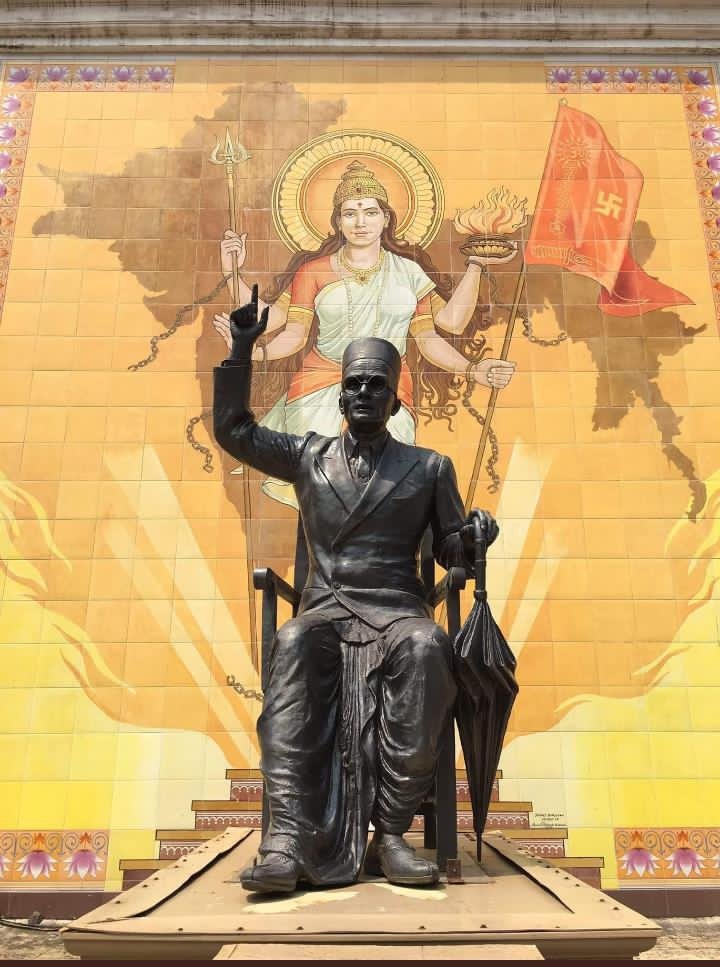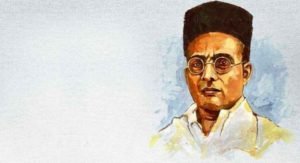What did Veer Savarkar do for his motherland ?


“Oh Motherland, Sacrifice for you is like life and Living without you is death!!”, these were the words of the brave son of Ma Bharti who sacrificed his whole life for his punyabhumai and went up to change the entire discourse of Bharat. Back then he was a source of inspiration for Bhartiyas and also today he continues to be the guiding light for Bhartiyas.

Ever since the Modi government came into power, Veer Savarkar has always been in the middle of the debates between the right wing and left wing of the political spectrum. Veer Savarkar has always been a controversial figure. The Marxist historians and the intellectuals from the left side of the political spectrum has always tried to show Veer Savarkar as a devil figure which is far too away from the reality. These leftist historians and intellectuals have always tried to cover up reality with a sheet of their propaganda. There are many myths which are being spread into the public through these hindu hating intellectuals which are against Veer Savarkar. Savarkar played a huge role in the freedom of this sacred land. Savarkar was born a nationalist , right from his school days, could be easily witnessed in his eyes.

On 7th of October 1905, a huge bonfire of foreign-made clothes was lit across from ‘Lakdi Pul’ in Pune.This was part of the nationwide agitation launched by Tilak to protest against the partition of Bengal.The Pune bonfire was led by Veer Savarkar, who was then a student at Fergusson. Savarkar was also the one who organised the earliest secret societies in India , Abhinav Bharat (mitra mela) along with his brother Ganesh Savarkar whose main objective was to throw away the British colonial government from the sacred land of Bharat. It carried out a few assassinations of British officials.Veer Savarkar was the one who gave a call for complete freedom when the men from Congress were asking for concessions from the British government.Savarkar’s revolutionary thoughts led to the assassination of Lt. Col. William Curzon-Wyllie, the political aide-de-camp to the Secretary of State for India, by Madanlal Dhingra on the evening of 1st July 1909, at a meeting of Indian students in the Imperial Institute in London. Dhingra was arrested and later tried and executed. A. M. T. Jackson, the district magistrate of Nasik, was assassinated in India by Anant Laxman Kanhare in 1909 in the historic Nasik Conspiracy Case. Savarkar emerged as a firebrand revolutionary in the five years he spent in London. While staying in London he always work for the freedom of this sacred land. Many bombing and assassinations were carried out keeping the freedom of Bharat in mind. The investigation into the Jackson assassination revealed the existence of the Abhinav Bharat Society and the role of the Savarkar brothers in leading it. Vinayak Savarkar was found to have dispatched twenty Browning pistols to India, one of which was used in the Jackson assassination. A trial was being held in India which is popularly known as “Nasik Conspiracy trial” and “Nasik murder trial”, two simultaneous trials which can be termed as the most unfair of trails because due trial was without a jury or without a right to lawyer. Following the trail, the punishment that came up to Veer Savarkar was a 2 life terms of imprisonment , each life imprisonment lasted for 25 years. So he was awarded the sentence of 50 years in Kala Pani which was the maximum given to anybody. He was charged in the Jackson murder and sentenced to “transportation” for life. Savarkar was imprisoned in the Cellular Jail in the Andaman Islands in 1910. He went through the hard punishment of Kala Pani for his motherland.During his term in the Kala Pani he had to face many inhumane tortures. Veer Savarkar was given a 6 months solitary confinement ,even basic facilities were not provided to him like toilet and good food. Veer Savarkar wrote a book about the first war of independence which got published in 1909. This book which he wrote became widely popular and became a basic book for every freedom fighter. Bhagat Singh drew a lot of inspiration from Veer Savarkar. In fact the criteria to recruit freedom fighters into the HSRA (Hindustan Socialist Republican Association)by Bhagat Singh was whether the new recruit read the book written by Veer Savarkar on the First War of Independence, this was revealed by a Congressman Durga Das Khanna who was also a former member of Hindustan Socialist Republican Association (HSRA).The copy of this book was found with every revolutionary who was accused in the Lahore Conspiracy Case in 1930s and later Rash Behari Bose and Netaji Subhash Chandra Bose got this book of Veer Savarkar published in Japanese. 1857 uprising today is known as First War of Independence because of Veer Savarkar. Veer Savarkar provided a lot of support to Rash Behari Bose who called Veer Savarkar as a great Indian patriot and a very symbol of valour and sacrifice. Rash Behari Bose was the one who along with Subhash Chandra Bose took up the Indian National Army. Veer Savarkar asked the youth of the country to join the British army with an objective in his mind. Savarkar asked the youths to join the British army and take training of warfare from there and when the time comes, leave the Army to join the fight for the freedom of this country. Savarkar tried to create another Sepoy mutiny from the British army. Netaji Subhash Chandra Bose himself while addressing in a radio in 1945 said that it was Savarkar who enlisted a lot of young men into the Indian Army and most of them crossed over to the INA from the British army and that is how INA got its recruits. It was Hindu mahasabha led by Veer Savarkar which was the only political organisation who till it’s last breath fought against the partition of India when almost every political organization accepted the reality. But sadly the great man was treated with respect the way he deserved. On 30th January 1948, Nathuram Godse shot Gandhi from point-blank range. Gandhi died on spot. Indian state punished Godse for that and hanged him for killing a person who had advocated for non-violence throughout his life. However, even before Godse’s hanging, the revengeful Congressi had decided to use Gandhi’s killing as a justification for the Chitpavan Brahmin massacre in Maharashtra.The massacre started from Mumbai. Hours after Gandhi was killed, a wave of violence swept over whole Maharashtra. Chitpavan Brahmins, the class of Brahmins to which Nathuram Godse belonged were the main targets of groups committing violence.For the next 4 to 5 days, Chitpavan Brahmins were subject to Mughalesque era killings, rapes, and lootings from Congressis in collusion with anti-Brahmin groups.The series of killings started as soon as Gandhi’s assassination news reached Maharashtra. Official accounts suggest that at least 15 people were killed in Mumbai on the very next day of Gandhi’s death.Soon, the anti-Brahmin wave spread to the whole of Maharashtra. The homes of Chitpavan Brahmins were systematically identified, their women were raped, men were killed and then the houses were burnt.Congress took it on a mission mood to destroy everything which had even an iota of Chitpavan mark on it. Not just houses were burnt, but even factories and offices which provided jobs were not left by the rioters.
The massacre was systematically planned as mobs possessed everything to destroy anyone coming in their way. No matter where mobs reached, they were armed with Kerosene canisters, rods, machetes. Buildings were attacked with cotton balls and kerosene-soaked paper and then they were burnt. The anarchy can be gauged from the fact that even children were butchered like animals by these Congress supported goons. Not even those whose families spent their whole life serving the nations were spared. Veer Savarkar’s properties were destroyed, and his brother Veer Narayan Savarkar was pelted to death by the mob. On the killing of his brother, Savarkar had written, “He who relentlessly served the nation, He who relentlessly worked for the people, He who stood firm against the Brits, He who fought for liberating Maa Bharati, Today was stoned to death by his own brothers for whom he fought” .Violence spread to 300 districts
The activities were not limited to a few districts. Kolhapur, Solapur, Satara, Sangli and Pune became the main centres of Chitpavans’ genocide due to the well-organised nature of killings, Chitpavans living in 300 districts of 13 talukas were forced to either die or flee from the state.
It is disheartening to see people making fun of a great freedom fighter who sacrificed his whole life for this motherland. People like Rahul Gandhi and Manishankar Iyer will not decide the legacy of Veer Savarkar, but the people of oldest civilization will. Still many politicians hesitate to pay Veer Savarkar the kind of respect he deserves. He lived for his matribhumi, he sacrificed for his matribhumi, he contributed to his matribhumi and he left his works for the future of his matribhumi.
DISCLAIMER: The author is solely responsible for the views expressed in this article. The author carries the responsibility for citing and/or licensing of images utilized within the text.
